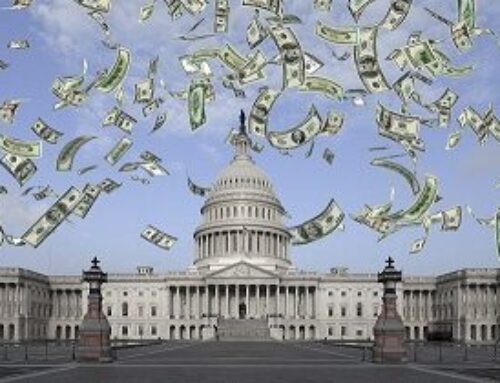In keeping with President Obama’s call to end fossil fuel subsidies, the latest budget proposal includes several significant cuts to oil, gas and coal subsidies. More than $43 billion are targeted at the oil and gas industry and over $2.5 billion in cuts are directed towards the coal industry.
Similar to last year’s budget request, the fiscal year FY2012 budget repeals several long-standing oil and gas subsidies, saving an estimated $43.61 billion over the next ten years. The FY2012 budget also proposes the elimination of $2.58 billion in coal subsidies. In addition, general tax and subsidy reforms will save $115.08 billion, largely from subsidies that benefit the oil and gas industries. For nearly a century, taxpayers have provided billions of dollars in subsidies to the oil and gas industry, this proposal takes the first step toward reining in decades of giveaways.
Details of the Proposed Oil and Gas Cuts
The president’s budget proposes repealing the Manufacturing Tax Deduction, Percentage Depletion Allowance, Expensing of Intangible Drilling Costs, Preferential Time Period Treatment for Geological and Geophysical Amortization, Passive Loss Exemption, and Deduction for Tertiary Injectants. In addition, the budget removes the Enhanced Oil Recovery and Marginal Well tax credits, cuts oil research and development funding, reforms abuses of the Foreign Tax Credit (FTC) and prohibits Last-In First-Out (LIFO) inventory accounting.
The largest taxpayer savings will result from the repeal of the Manufacturing Tax Deduction, enacted under the American Jobs Creation Act of 2004. This tax loophole essentially allows oil and gas producers to deduct 6% of their taxable income from qualified activities in the United States. If this subsidy is repealed, savings over the next ten years will total $18.260 billion.
The president’s budget also creates $11.202 billion in taxpayer savings by eliminating the Percentage Depletion Allowance (PDA) for oil and gas companies. PDA was enacted in 1926 for depletable resources such as oil, gas and minerals. Rather than the typical cost-depletion method, based on exhaustion of property, the Percentage Depletion Allowance enables recovery of capital costs at a general rate of 15%, and potentially up to 25%. Because the Percentage Depletion Allowance applies only to depletable resource property, producers can claim the depletion even after they recoup capital costs.
The repeal of the Expensing of Intangible Drilling Costs (IDC) loophole, enacted in 1916, will save the U.S. Government $12.447 billion over the next ten years. Under this tax break, oil and gas companies enjoy exemption from uniform capitalization rules that require the costs associated with property to be considered inventory, or capitalized as part of the property basis. Alternately, oil and gas companies can choose to either expense IDCs immediately, or capitalize and amortize IDCs at an accelerated rate. Both alternatives lead to substantial tax benefits for the oil and gas industries.
The Administration’s budget achieves $1.408 billion in savings by eliminating several other wasteful programs including the Preferential Time Period Treatment for Geological and Geophysical Amortization that allows oil and gas companies to write off costs incurred while searching for oil and gas deposits. The budget also ends the Passive Loss Exemption, established with the Tax Reform Act of 1986, that allows taxpayers to deduct losses on working investments in the oil and gas industry—so long as the taxpayer is not “materially involved” in the business’ activity. Also cut is the Deduction for Tertiary Injectants, established as part of the Crude Oil Windfall Profit Act of 1980, which allows oil producers to deduct the cost of injecting fluids into oil reservoirs in order to remove very viscous oil. Eliminating these two programs will save a total of $295 million over the next 10 years.
Notably, the budget eliminates the Department of Energy’s Ultra Deepwater Oil and Gas R&D program, worth $190 million over the next ten years. The program was meant to encourage the development of technology to tap hard to reach oil reserves far off the coast. However, spending was encouraged by a handful of politicians and has been directed toward a select few oil and gas companies. See the chart below for a breakdown of program eliminations and savings
|
Table 1: Repealed Oil and Gas Subsidies and Tax Breaks in the 2012 Budget Request |
|
|
Subsidies and Credits |
Taxpayer Savings 2012-2021 |
|
Repeal Enhanced Oil Recovery Credit |
*
|
|
Repeal Marginal Well Tax Credit |
*
|
|
Repeal Expensing of Intangible Drilling Costs |
12,447,000,000
|
|
Repeal Deduction for Tertiary Injectants |
92,000,000
|
|
Repeal Passive Loss Exemption for Working Interests in Oil and Natural Gas Properties |
203,000,000
|
|
Repeal Manufacturing Tax Deduction for Oil and Natural Gas Companies |
18,260,000,000
|
|
Eliminate Preferential Time Period Treatment for Geological and Geophysical Amortization Period for Independent Producers |
1,408,000,000
|
|
Repeal Percentage Depletion for Oil and Natural Gas |
11,202,000,000
|
|
Terminate Oil Research and Development Program |
190,000,000
|
|
Total
|
$43,802,000,000 |
One noteworthy provision aimed at collecting a fair royalty from oil and gas companies was omitted from the FY2011 and FY2012 budget. The FY2010 budget proposed a new excise tax on offshore oil and gas production—to address billions of taxpayer dollars that are being lost on royalty-free leases in the Gulf of Mexico under the Deep Water Royalty Relief Act (DWRRA). Leases issued under the Act were intended to have price triggers to invoke royalties when gas prices reached above $36 barrel. These leases were issued at a time when crude oil prices were only $18/barrel. With oil prices reaching well over $100 a barrel repeatedly in the last five years, these leases should all be paying royalties.
According to the Government Accountability Office, lost royalties on DWRRA leases could cost up to $53 billion in revenue over the next 25 years. In order to correct this error and recover royalties, the president has proposed placing a 13% excise tax on oil leases in the Gulf of Mexico that are not currently paying any royalties. This excise tax would raise $5.3 billion in tax revenues over the next 10 years, according to the updated budget summary from May 2009. It is important federal taxpayers receive a fair royalty on all offshore leases. All resources extracted from federal lands and waters must pay a royalty to the owners of the resource—U.S. taxpayers.
Other Tax Proposals that Impact Oil and Gas
In addition to cutting almost $44 billion in direct subsidies and tax breaks to the oil and gas industry, the President’s FY2012 budget proposal tackles two tax loopholes that benefit oil gas companies: the Foreign Tax Credit (FTC), and Last-in, Fist-out (LIFO) accounting methods. The Administration does not delineate how much in savings will come directly from the oil and gas industry, but estimates that total taxpayer revenue for repealing these tax loopholes will be $62.202 billion for the FTC and $52.88 billion for LIFO, for a combined total of $115.082 billion in savings from 2012-2021.
The Foreign Tax Credit was established to prevent U.S. businesses—and U.S. citizens living abroad—from being double-taxed on income earned in foreign countries. The FTC allows U.S. companies and individuals to count foreign income taxes as a credit on taxes owed in the U.S. Unfortunately, the FTC contains a loophole that allows oil and gas companies to count royalty payments to foreign governments as income tax that can be counted dollar-for-dollar against U.S. tax payments. These royalty payments are usually fees for extracting oil and gas from public lands and counting them as income tax is an accounting fallacy.
The President’s budget proposes reforming the FTC by requiring companies to pool and report on all of their foreign income, not just transactions they owe U.S. taxes on. This would provide more transparency for what is being counted as income tax that is eligible for a tax credit, reclaiming $51.444 billion in lost tax revenue from 2012-2021. Similarly, tax rules for “dual capacity taxpayers” would be modified so business fees cannot be counted as a creditable tax. Taxpayers are considered dual capacity if they are subject to a levy that is both a general tax and a fee for “specific economic benefits” from the country (i.e. royalty payments). The President’s budget proposes modifying these rules so that fees for economic benefits cannot be counted as creditable taxes. This modification would save taxpayers a total of $10.758 billion from 2012-2021. In total, these reforms to the Foreign Tax Credit will save $62.202 billion over the next 10 years. The Administration has not calculated what portion of these savings will come directly from the oil and gas industries, but these reforms will directly impact the business practices of oil and gas companies.
Last-in, first-out (LIFO) accounting methods are also repealed for all industries in the budget request. Because of inflation and general rising costs, LIFO allows companies to move the most expensive inventory off of their balance sheets, and thereby reduce their taxable income, even though the actual movement of inventory occurs on a first-in, first-out (FIFO) basis in most industries. LIFO is already prohibited by International Financial Reporting Standards. The repeal of LIFO applies to all industries, including oil and gas, and will create savings of $52.88 billion over the next ten years.
|
Table 2: General Business Reforms for Oil and Gas Companies |
|
|
Subsidies and Credits that Benefit Oil and Gas Companies |
Taxpayer Savings, 2012-2021 |
|
Reform Foreign Tax Credit: Determine the Foreign Tax Credit on a Pooling Basis (FTC) |
51,444,000,000
|
|
Modify Tax Rules for Dual Capacity Taxpayers
|
10,758,000,000
|
|
Total, Foreign Tax Credit Reforms |
62,202,000,000
|
|
Last-in, First-out Accounting (LIFO)
|
52,880,000,000
|
|
Total: |
$115,082,000,000* |
| *Note: savings across all industries in the U.S., not just oil and gas industry. | |
Details of the Proposed Cuts to Coal Subsidies
The president’s FY2012 budget request also includes $2.579 billion in coal subsidy cuts, targeting the same cuts that were suggested in FY2011. The budget proposal suggests that these cuts are in response to the president’s commitment, made at the G-20 summit in the fall of 2009, to end all fossil fuel subsidies over the medium term. Four subsidies would be repealed: Expensing of Exploration and Development Costs, Percentage Depletion for Hard Mineral Fossil Fuels, Capital Gains Treatment for Royalties, and the Domestic Manufacturing Deduction for Coal and Other Hard Mineral Fossil Fuels.
Repealing Expensing of Exploration and Development Costs would save taxpayers $447 billion between 2012-2021. This subsidy allows coal companies to deduct the cost of exploration and development from income taxes, even though these activities often lead to future profit. Similarly, the Percentage Depletion Allowance allows coal companies to recover capital costs at 10%. Repealing this tax subsidy would recover $1.353 billion in lost revenue over the next ten years. The budget also eliminates Capital Gains Treatment for Royalties, which allows coal companies to treat royalty payments on coal reserves as capital gains income, which has a lower tax rate than regular income. Correcting this tax loophole would save taxpayers $369 million. Finally, the FY2012 budget proposes repealing the Domestic Manufacturing Deduction for Coal and Other Hard Mineral Fossil Fuels for a savings of $410 million from 2012-2021. Coal companies are currently able to deduct up to 9% of the cost of domestic manufacturing activities from income taxes. In total, eliminating these four tax preferences for the coal industry would save taxpayers $2.579 billion from 2012-2021.
Drilling Down on Fossil Fuel Subsidies
We are pleased to see the Administration taking a strong stance against subsidies to the oil, gas and coal industries. As stated in the budget request “The oil and gas subsidies are costly to the American taxpayer and do little to incentivize production or reduce energy prices.”
We applaud the Administration for proposing the repeal of the above loopholes, tax breaks and subsidies. However, more must be done to end the billions in other wasteful subsidies to the fossil fuel industry as well as other mature energy industries. The Administration is taking the first steps in ending the long-standing flow of U.S. taxpayer dollars to an industry that does not need handouts.
For more information, please contact Autumn Hanna at (202) 546-8500 x112 or autumn [at] taxpayer.net.











Get Social